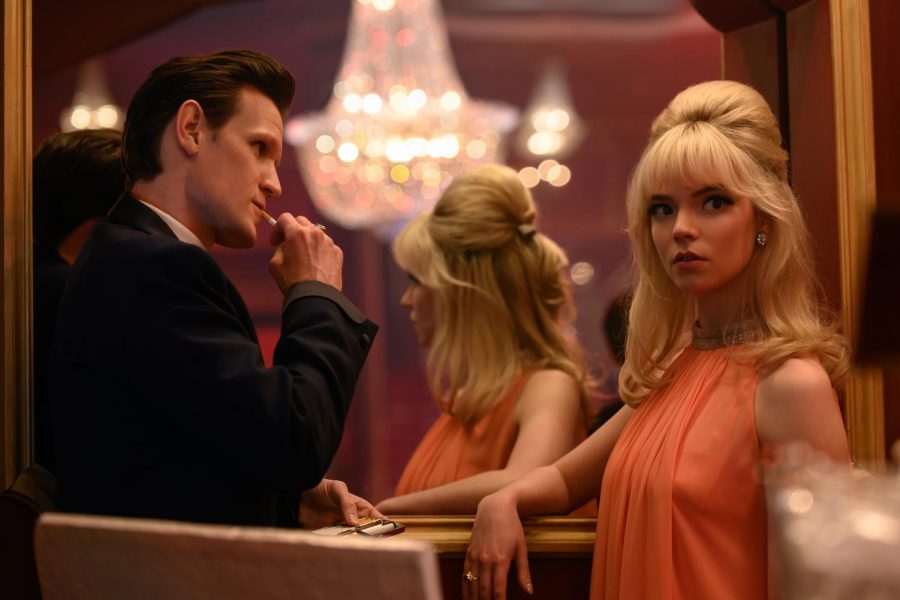Review: ‘Last Night in Soho’ ditches comedy for horror
A mixed bag of great influences, the latest film from Edgar Wright is jumbled in its execution.
Edgar Wright’s new film “Last Night in Soho” is both a horror film and a nostalgic depiction of 1960s London. The story is told from the perspective of modern teenager Eloise Turner (Thomasin McKenzie) as she follows aspiring singer Sandie (Anya Taylor-Joy) and Sandie’s career-serving romantic relationship with Jack (Matt Smith). (Image courtesy of Focus Features)
November 16, 2021
Edgar Wright’s Three Flavours Cornetto Trilogy — Shaun of the Dead, Hot Fuzz and The World’s End — are some of the smartest comedies of this century, especially in the way they play with their genres: zombie horror, cop action and apocalyptic sci-fi. Each film expertly executes the tropes of its genre, achieving self-referential humor without being distractingly meta. With “Last Night in Soho,” Wright tries to shed some of those comedic inclinations in favor of a straightforward horror film. Unfortunately, the result is a film that could have been pushed further.
Eloise “Ellie” Turner (Thomasin McKenzie) is a first-year fashion design student at the University of the Arts London. Moving from the countryside to the big city quickly proves to be challenging. Her roommate Jocasta (Synnøve Karlsen) seems much more successful in her college life and career pursuits, and she quickly conflicts with Eloise. This is stuff that’s easily relatable to college students. However, it’s all handled on such a surface level, it feels like something a film student lacking retrospect would make while still in school (don’t worry, I’m ragging on my own kind).
Eloise decides to move out, finding herself in a flat above a French bistro owned by Ms. Collins (Diana Rigg). When she goes to sleep, she finds herself transported to 1960s London, where she follows the endeavors of aspiring singer Sandie (Anya Taylor-Joy). The nostalgic perspective that Eloise brings with her to the past is lavishly rendered, the nightlife taking on a joy unfelt in modern times when Eloise goes out with her classmates or works at her job. Taylor-Joy is great as a desperate singer who consorts with Jack (Matt Smith) in a ploy to advance her career. However, she quickly realizes that he, as well as all the other connected men in the London entertainment industry, expect sexual favors from her in exchange for their assistance. The connections to the modern film industry and the #MeToo movement are easy to make.
The film’s messages about nostalgia and shitty men are nothing revolutionary, though it’s refreshing to see them come from a male director for a change. What undercuts Wright’s good intentions, however, is the film’s twist. Sandie’s relationship with Jack worsens, and while Eloise is hooking up with a partner in her own time, she has a vision where Jack stabs Sandie repeatedly. Eloise makes it her mission to find Jack in the present day, her lead being an old man (Terence Stamp) she often sees around the bar; with match cuts, the film suggests that he is an older Jack. Eloise confronts him and finds out that the man, Lindsey, did know Sandie, but he was an undercover cop. Instead of the obvious answer, it turns out that Eloise’s landlady Ms. Collins is the Sandie that she has been following in her dreams. In fact, Ms. Collins is the murderer of Jack and countless other gentlemen.
This plot twist would’ve aligned better with the themes that the film attempts to present if Ms. Collins was vindicated in taking her revenge. Instead, she becomes the villain and nearly kills Eloise and her boyfriend John (Michael Ajao). After the film climaxes in a staircase chase scene, the building burns up and Ms. Collins decides to spare Eloise. Ms. Collins dies a tragic figure in the very room where she suffered her traumas. Any potential for closure, where the audience could say “good for her,” is burnt up in that room. The epilogue shows Eloise presenting her own showcase as a designer, which contrasts uncomfortably with the preceding sequence. It’s as if Eloise didn’t spend enough time mourning the woman that she had sought answers for — as if she’s moved on just fine.
Outside of plotting, the film’s style is both an asset and a fault. Visually, Wright is at his strongest when he’s recreating the ’60s, and his affection for the time seeps into his casting choices: Stamp and Rita Tushingham, who plays Eloise’s grandmother, are both stars of the 1960s British film industry. Wright’s knowledge of cinema history is evident and admirable. Occasionally, though, the film fails to achieve the tension necessary for a horror movie due to its focus on paying homage to its filmic roots. The film’s giallo influences have been widely publicized, though “Last Night in Soho” isn’t nearly as cheesily bloody as any of those films.
Returning to the film’s first act, where Eloise fails to get along with her roommates, the sequence bears similarities to one from Dario Argento’s 1977 film Suspiria — his protagonist also has to move to another place where the film’s horrors are subsequently unleashed. However, though both films are cheesy, Argento’s succeeds in fully committing to the kitschiness of the story — its tone, visuals and acting form a cohesive work that finds beauty in not taking itself too seriously. Wright, on the other hand, uses a slick, polished visual style that feels too dramatic for his potentially humorous story. The giallo genre has plenty of potential for comedy, and Wright has skillfully found the humor in horror before in “Shaun of the Dead.” Wright needs to embrace his comedic origins or fully ditch them as well as its stylistic residue. Either way, “Last Night in Soho” shows that Wright is a competent and well-read artist, and I’m looking forward to his next film.
Contact Sebastian Zufelt at [email protected].






























































































































































